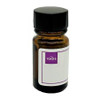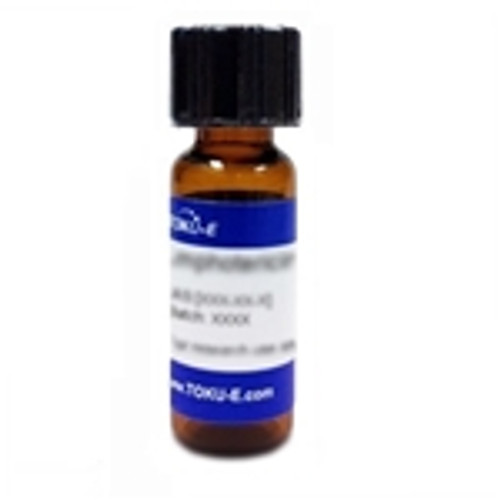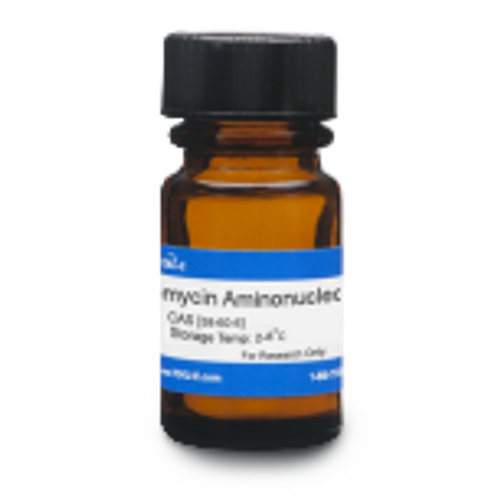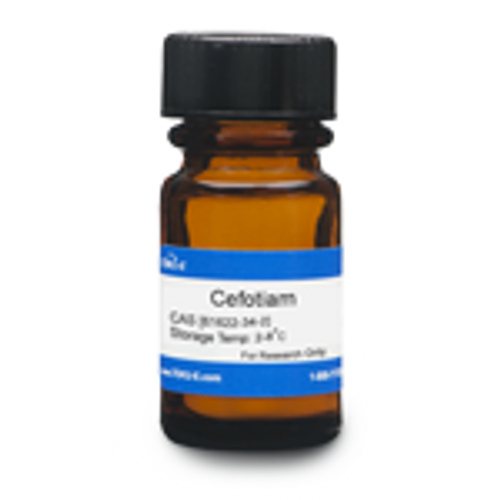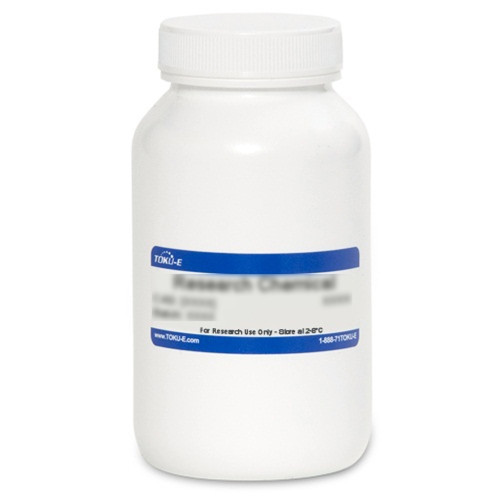Puromycin Dihydrochloride (syn: Puromycin DiHCl) is the hydrochloride salt of Puromycin, an aminonucleoside antibiotic with anti-trypanosomal and anti-neoplastic properties. Puromycin was isolated from Streptomyces alboniger in the 1950s. Puromycin DiHCl is routinely used in cell culture as a selective agent in transfection and transformation protocols to select for cells that have been transformed with the Puromycin resistance gene (pac) and express puromycin-N-acetyl-transferase.
We also offer:
- Puromycin (P097)
- Puromycin Aminonucleoside (P041)
- Puromycin DiHCl Solution (10 mg/ml in 20 mM HEPES)(P025-P026)
| Mechanism of Action | Puromycin Dihydrochloirde inhibits protein synthesis in two ways: 1) Puromycin associates with the donor substrate, peptidyl-tRNA, in the P site and functions as an acceptor substrate. 2) Puromycin DiHCl can compete with aminoacyl tRNA to bind with the A′ site within the peptidyl transferase center causing premature chain termination. Resistance to Puromycin is conferred by the pac gene, a 60 nt fragment that encodes puromycin N-acetyltransferase. The enzyme inactivates Puromycin by acetylating the amino group in the tyrosinyl moiety. Acetylated Puromycin is biologically inactive and does not associate with prokaryotic or eukaryotic ribosomes. |
| Spectrum | Puromycin can prevent growth of bacteria, algae, protozoa, and mammalian cells and acts quickly, killing 99% of cells within 2 days. Puromycin DiHCl is active against both prokaryotic and eurkaryotic cells. It is active against Gram-positive bacteria and less active against Gram-negative and acid-fast bacilli. |
| Microbiology Applications | Puromycin Dihydrochloride can be used to select for Puromycin resistant bacteria that have been transformed with the pac gene. Resistant E. coli transformants can be isolated on pH adjusted LB medium using a Puromycin concentration of 100-125 µg/mL.
Puromycin DiHCl can also be used as a selectable marker in mollicute research and has been successfully used to select for various Mycoplasma species after transformation with the Puromycin resistance gene (pac). Tetracycline is traditionally used as a selectable maker for Mycoplasma; however, Puromycin does not have any clinical value, is a potent protein synthesis inhibitor, and can be used to screen for a wide range of Puromycin resistant Mycoplasma spp. Because of its unique mechanism of action, there is a low possibility of spontaneous resistance to Puromycin by a point mutation. |
| Eukaryotic Cell Culture Applications |
Puromycin Dihydrochloride has been used to screen cells transfected cells with the CRISPR/Cas system, by co-transfecting a resistance plasmid, and screening with Puromycin as a selection marker.
Effective working concentrations for selection of puromycin resistant cells range from 0.5 – 10 µg/mL. The optimal working concentration of Puromycin Dihydrochloride for selection of resistant mammalian clones depends on the cell lines used, Puromycin quality, media, growth conditions, cell density, cell metabolic rate, cell cycle phase, and the plasmid carrying the pac resistance gene. A kill curve should therefore be performed to determine the optimal working concentration for every experimental system and for every lot of Puromycin dihydrochloride. Optimal selection concentrations of Puromycin typically range from 0.5 µg/mL - 2 µg/mL for suspended cells and 2 µg/mL - 5 µg/mL for adherent cells. For Puromycin kill curve protocol, click here. For additional information regarding relevant cell lines, resistance plasmids, and culture media, please visit our cell culture database. |
| Cancer Applications |
Puromycin Dihydrochloride has shown anti-tumor activity when tested against numerous cell lines. A novel prodrug strategy targeting increased histone deaceylase (HDAC) and endogenous protease cathepsin L (CTSL) activities in malignant tumors. The cancer-selective cleavage of the small-molecule masking group may be a strategy for anticancer compound development. By coupling an acetylated lysine group to Puromycin (from TOKU-E), a masked cytotoxic agent is created, which is activated by HDAC and CTSL that removes the acetyl group followed by the unacetylated lysine group, liberating Puromycin. This could be a promising strategy for anticancer compound development (Ueki et al, 2013). Ring finger protein 43 (RNF43) is known for its role in negative regulation of the Wnt-signaling pathway in cancer. However, the function in DNA double-strand break repairs has not been investigated. Researchers used cellular models (lymphoblast cell line, DT40 along with mouse embryonic fibroblast) to study DNA double-strand break (DSB) repairs. They used Puromycin DiHCl from TOKU-E EU for selection of transfectants for RNF43-/- screening ( |
| Molecular Formula | C22H29N7O5 · 2HCl |
| References |
Conti et al. used Puromycin DiHCl (TOKU-E) to select for eGFP expressing A549 cells. "Polymeric nanocarriers and their oral inhalation formulations for the regional delivery of nucleic acids to the lungs." Lerkusuthirat et al. used Puromycin DiHCl (TOKU-E) for selection of transfectants for RNF43 -/- screening in cancer research. ''A DNA repair player, ring finger protein 43, relieves etoposide-induced topoisomerase II poisoning.'' Lu et al. used Puromycin DiHCl (TOKU-E) to select for transfected AS-B145 and BT-474 cells. "Ovatodiolide inhibits breast cancer stem/progenitor cells through SMURF2-mediated downregulation of Hsp27"
Algire MA (2009) New selectable marker for manipulating the simple genomes of Mycoplasma species. Antimicrob. Agents and Chemother. 53(10):4429-4432 Azzam ME (1973) Mechanism of Puromycin action: Fate of ribosomes after release of nascent protein chains from polysomes." PNAS 70.12:3866-3869. Lacalle R et al (1989) Molecular analysis of the pac gene encoding a puromycin N-acetyl transferase from Streptomyces alboniger. Gene. 79:375-380 A DNA repair player, ring finger protein 43, relieves etoposide-induced topoisomerase II poisoning. Genes Cells. 25:718–729 Ueki N et al (2013) Selective cancer targeting with prodrugs activated by histone deacetylases and a tumor-associated protease. Nat. Commun 4:2735 Vara J (1985) Cloning and expression of a Puromycin N-acetyl transferase gene from Streptomyces alboniger in Streptomyces lividans and Escherichia coli. Gene 33(2):195-206 |
| Protocols |
Puromycin Dihydrochloride Kill Curve ProtocolBackground:Puromycin Dihydrochloride (DiHCl) is an aminonucleoside antibiotic derived from Streptomyces alboniger and is routinely used as a selective agent for mammalian cells that have been transformed or transfected with plasmids containing the puromycin resistance gene, pac. Before stable transfected cell lines can be selected, the optimal Puromycin DiHCl concentration needs to be determined by performing a kill curve titration. The optimal concentration of Puromycin DiHCl suitable for selection of resistant mammalian clones depends on the cell lines, media, growth conditions, and the quality of Puromycin DiHCl but typically lies between 1 µg/mL - 10 µg/mL. Because of these variables, it is necessary to perform a kill curve for every new cell type and new batch of Puromycin DiHCl. Preparation and storage of Puromycin DiHCl solution: Puromycin DiHCl is soluble in water at 50 mg/mL yielding a clear, colorless to faint yellow solution. Store filter-sterilized (0.22 μm) stock solutions solutions in aliquots at –20 °C. Kill curve/Puromycin DiHCl titration protocol:
Plasmid DNA Transfection ProtocolBackground: Once the appropriate antibiotic concentration to use for selection of the stable transfected cells has been determined by performing a kill curve, the next step is to generate a stable cell line by transfection of the parental cell line with a plasmid containing the gene of interest and an antibiotic resistance gene.
Plasmid DNA Transfection Protocol:
QC Seed 24-wells with insert and determine the transfection efficiency by immunostaining:
Selection of Stable Transfected Cell Lines ProtocolBackground: Once the cells have been successfully transfected, the next step is to seed and select the transfected cell line in a single 96-well plate to select pure colonies by limited dilution as outlined below: Protocol:
QC Seed 24-wells with insert for an immunostaining to determine percentage of cells expressing the gene of interest to be able to identify a 100% pure clone. You can also use Western blotting, flow cytometry or another technique depending on the cell line used. Seed 24-wells with insert and determine the expression level of the gene of interest by immunostaining:
|


